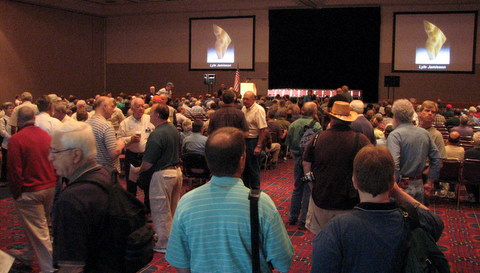 This is from the Opening Ceremonies of the AAW’s 2007 Symposium. They announced that over 1600 people are registered for this event, making it the “second largest of its kind” (whatever that means). I think that you can see from this picture that the vast majority of members are: white, male, and over 50 (hey, that’s me!). There are women, there are people of color, and there are younger turners out there, and many of them are prominent members in the field. There are even young women of color, but the majority is pretty much represented in this picture. Still, it’s the friendliest group I’ve ever been involved with.
This is from the Opening Ceremonies of the AAW’s 2007 Symposium. They announced that over 1600 people are registered for this event, making it the “second largest of its kind” (whatever that means). I think that you can see from this picture that the vast majority of members are: white, male, and over 50 (hey, that’s me!). There are women, there are people of color, and there are younger turners out there, and many of them are prominent members in the field. There are even young women of color, but the majority is pretty much represented in this picture. Still, it’s the friendliest group I’ve ever been involved with.
And, it’s an early rising group. I took that first picture at 7:45 AM, just as the meeting started! One of many reasons Harriet doesn’t typically come to these events with me.
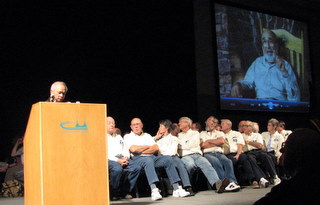 During the opening ceremonies, there was a tribute to a prominent woodturner who died this last year. Frank Sudol died at the age of 73, and was a well loved and respected, Canadian woodturner. Speaking at the podium is Binh Pho, a student of his and one of the top 5 artists in this medium. It was a fine memorial and highlighted both Frank’s work and his thoughts on creativity. I sat in on one of his talks several years ago, and I feel his reputation as an artist and a mentor were well deserved.
During the opening ceremonies, there was a tribute to a prominent woodturner who died this last year. Frank Sudol died at the age of 73, and was a well loved and respected, Canadian woodturner. Speaking at the podium is Binh Pho, a student of his and one of the top 5 artists in this medium. It was a fine memorial and highlighted both Frank’s work and his thoughts on creativity. I sat in on one of his talks several years ago, and I feel his reputation as an artist and a mentor were well deserved.
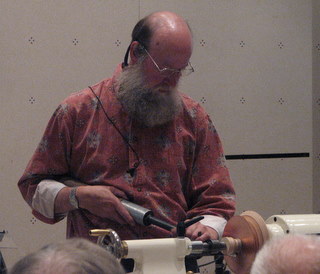 The central part of the symposium are the demonstrations. There are 11 time slots (called rotations) over the course of 3 days, and in each rotation there are approximately 14 different talks that you can choose from. There are demonstrations of techniques and practices (both beginning and advanced), sessions discussing design, retrospectives on the works of artists, and advice for the professional turners (studio and production). This picture is of Bill Moore during the first rotation where I attended his Metal Spinning for the Woodturner demonstration.
The central part of the symposium are the demonstrations. There are 11 time slots (called rotations) over the course of 3 days, and in each rotation there are approximately 14 different talks that you can choose from. There are demonstrations of techniques and practices (both beginning and advanced), sessions discussing design, retrospectives on the works of artists, and advice for the professional turners (studio and production). This picture is of Bill Moore during the first rotation where I attended his Metal Spinning for the Woodturner demonstration.
I’m not going to discuss all of the sessions, or even all of the sessions that I attend. Instead, I want to show some of the work that will be auctioned and others that are on display in the Instant Gallery.
During the symposium, anyone can bring in a couple pieces of their work to to be put out on display. This display is called the Instant Gallery, and this year there were 1359 pieces on display. To answer the obvious question, no, I did not have any of my work on display. I’m a pretty shy turner.
Along with the Instant Gallery, there are a number of pieces that are auctioned off to support the AAW’s education fund. Some of these pieces are donated by the best studio turners and reach fairly lofty values. There were 66 items in the auction this year.
I’m not going to show all of these pieces. Instead, I’ve picked out a few that I particularly liked. My camera died about half way through my viewing, so I’ll be back tomorrow with new batteries and some additional photos.
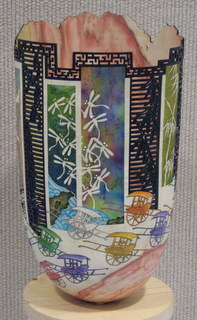 This is by Binh Pho. It is a very thin and light vessel that has been pierced with a design and then delicately painted using an airbrush. There is usually a lot of symbolism in Binh’s work, representing aspects of his life, including being raised in Vietnam. But interpreting the sybology isn’t critical to appreciating his work. It’s a gorgeous piece.
This is by Binh Pho. It is a very thin and light vessel that has been pierced with a design and then delicately painted using an airbrush. There is usually a lot of symbolism in Binh’s work, representing aspects of his life, including being raised in Vietnam. But interpreting the sybology isn’t critical to appreciating his work. It’s a gorgeous piece.
As I mentioned before, Binh Pho is recognized as one of the top woodturners in the field. His delicate vessels and their pierced and painted designs are instantly recognizable.
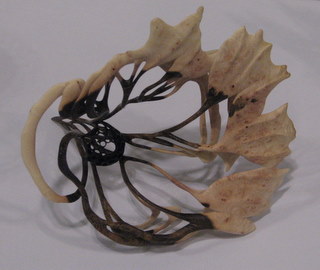 This is one of my favorite pieces in the whole show. Alain Mailland is a French turner and he does amazing abstract work. This piece is turned and then carved, but isn’t dyed. The colors in the work are from the natural colors of the woodd. I attended two of his sessions and was amazed and inspired by both of them.
This is one of my favorite pieces in the whole show. Alain Mailland is a French turner and he does amazing abstract work. This piece is turned and then carved, but isn’t dyed. The colors in the work are from the natural colors of the woodd. I attended two of his sessions and was amazed and inspired by both of them.
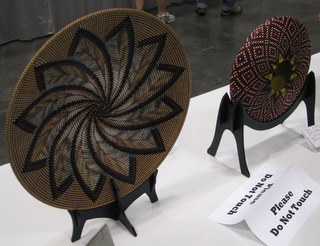 These are pieces by David Nittmann. They’re turned and then dyed in such a way that it looks like basketry. But, they aren’t just technical wizardry. These are gorgeuous pieces, and this one photo doesn’t do them justice. Unfortunately, my camera died just after this photo, so I’ll have to come back tomorrow with a better shot. I bought a piece by this artist several years ago, and his work has gotten better and better.
These are pieces by David Nittmann. They’re turned and then dyed in such a way that it looks like basketry. But, they aren’t just technical wizardry. These are gorgeuous pieces, and this one photo doesn’t do them justice. Unfortunately, my camera died just after this photo, so I’ll have to come back tomorrow with a better shot. I bought a piece by this artist several years ago, and his work has gotten better and better.
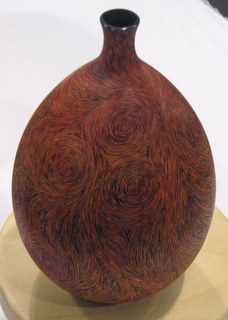 Jon Williams creates these lovely little pieces, and I’m very much drawn to the colors and the pattern. The colors are painted onto the surface, but the patterns are burned into the wood. The burning process is called pyrography and uses a sharp, heated tool that’s similar to a soldering iron. This makes the pattern more than just surface color. It also has a tactile component, and gives the images depth (that’s meant literally as well as figurately). There are a lot of woodturning artists using pyrography in their work nowadays, but I think those swirling patterns that he creates are beautiful.
Jon Williams creates these lovely little pieces, and I’m very much drawn to the colors and the pattern. The colors are painted onto the surface, but the patterns are burned into the wood. The burning process is called pyrography and uses a sharp, heated tool that’s similar to a soldering iron. This makes the pattern more than just surface color. It also has a tactile component, and gives the images depth (that’s meant literally as well as figurately). There are a lot of woodturning artists using pyrography in their work nowadays, but I think those swirling patterns that he creates are beautiful.
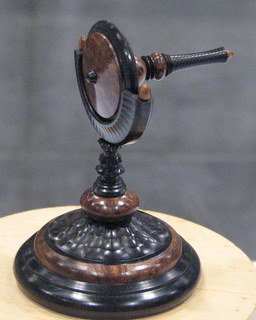 Jon Sauer makes these gorgeous tops from exotic hardwoods, and then carves them using a machine tool called an ornamental lathe. He uses several different pieces of wood in a single top and then turns them to have a beautiful form. They are also excellent spinners.
Jon Sauer makes these gorgeous tops from exotic hardwoods, and then carves them using a machine tool called an ornamental lathe. He uses several different pieces of wood in a single top and then turns them to have a beautiful form. They are also excellent spinners.
The stands are something new, and I think they complement the tops perfectly. The cantilever design is a new twist. Together, they make a very elegant display.
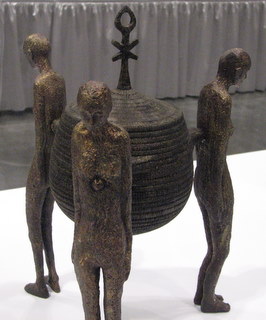 Jim Christiansen does work that fascinates me. They are the only pieces in the instant gallery that leave me with a strong emotional reaction. His current work uses figures along with the turnings and they evoke a lot of feelings. I enjoy a lot of turnings, finding them beatiful or fun, but his bring up strong emotions. I really like them. This piece and Alain’s piece are the two that I would most like to take home with me. Someday …
Jim Christiansen does work that fascinates me. They are the only pieces in the instant gallery that leave me with a strong emotional reaction. His current work uses figures along with the turnings and they evoke a lot of feelings. I enjoy a lot of turnings, finding them beatiful or fun, but his bring up strong emotions. I really like them. This piece and Alain’s piece are the two that I would most like to take home with me. Someday …
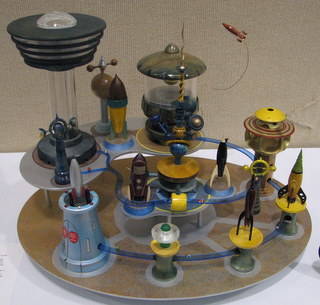 The AAW has a large number of member clubs that represent local regions (I belong to the Channel Islands Woodturners). At the symposium, there is a Chapter Challenge in which clubs come together and produce a group piece. There were 4 pieces in this years challenge, and I liked this one the best. It’s from the Glendale Woodturners Guild (from Southern California).
The AAW has a large number of member clubs that represent local regions (I belong to the Channel Islands Woodturners). At the symposium, there is a Chapter Challenge in which clubs come together and produce a group piece. There were 4 pieces in this years challenge, and I liked this one the best. It’s from the Glendale Woodturners Guild (from Southern California).
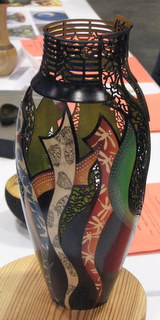 This is an amazing piece that will be in the auction tomorrow. It is a collaborative piece by Binh Pho and Frank Sudol. At the start of this post, I wrote that Frank Sudol died this last year, and Binh gave the memorial at the ceremonies this morning. Binh was a student of Frank’s , and they had wanted to do a collaborative piece for a long time. Just before he died they created this stunning pece of work, their only collaboration. It is an interesting mix of their styles, and both are clearly represented in this piece. I overheard some collectors speculating that they expect it will sell for between $10,000 and $12,000 at the auction. That would be an amazing price and probably well deserved.
This is an amazing piece that will be in the auction tomorrow. It is a collaborative piece by Binh Pho and Frank Sudol. At the start of this post, I wrote that Frank Sudol died this last year, and Binh gave the memorial at the ceremonies this morning. Binh was a student of Frank’s , and they had wanted to do a collaborative piece for a long time. Just before he died they created this stunning pece of work, their only collaboration. It is an interesting mix of their styles, and both are clearly represented in this piece. I overheard some collectors speculating that they expect it will sell for between $10,000 and $12,000 at the auction. That would be an amazing price and probably well deserved.
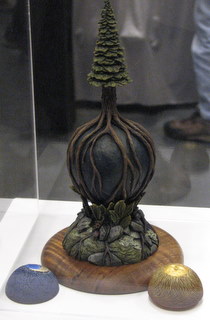 This is another piece that I believe will set the upper bar on prices at the auction. It is a collaborative effort between two very popular artists, Jacques Vesery and Bonnie Klein. From this picture alone, the piece may not look very impressive, but I happened to be nearby when the artists arrived to show off the piece to some friends. There are a lot of hidden surprises in the work. The ball has an image of the world carved onto it. It seperates from the base and can be opened like a box with a lid that unscrews. Inside is another ball with an image of the sun and the moon. That ball can also open up with another small blue marble inside which has a map of the world and the lettering “You are here” over Oregon.
This is another piece that I believe will set the upper bar on prices at the auction. It is a collaborative effort between two very popular artists, Jacques Vesery and Bonnie Klein. From this picture alone, the piece may not look very impressive, but I happened to be nearby when the artists arrived to show off the piece to some friends. There are a lot of hidden surprises in the work. The ball has an image of the world carved onto it. It seperates from the base and can be opened like a box with a lid that unscrews. Inside is another ball with an image of the sun and the moon. That ball can also open up with another small blue marble inside which has a map of the world and the lettering “You are here” over Oregon.
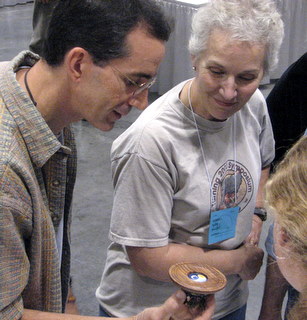 Here are the two artists of this piece, and Jacques is showing another of the hidden surprises. This is under the base. I’ve taken seminars and demonstrations from both of these artists and they are extremely nice people. Their collaborations are very popular with collectors, and I expect that this extraordinary piece will fetch a high value.
Here are the two artists of this piece, and Jacques is showing another of the hidden surprises. This is under the base. I’ve taken seminars and demonstrations from both of these artists and they are extremely nice people. Their collaborations are very popular with collectors, and I expect that this extraordinary piece will fetch a high value.
That’s it for this entry. As I mentioned, my camera’s batteries died, so I’m off to resupply and tomorrow I’ll have a few more pictures from the Galleries.
This was the last day of symposium, and I don’t really have many photos to throw at you all. This shot is of Alain Mailland demonstrating how he creates one of his amazing pod-like pieces.
One last picture, again from Alain Mailland’s demonstration. This is fairly far along in his work on the piece, and you get a pretty good sense of what the finished item will look like. What’s better than seeing the hands of a master craftsman in the middle of working on a piece of art?